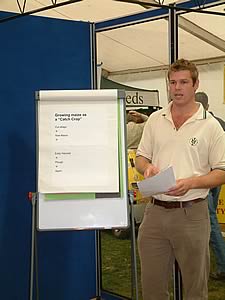22/09/06
New varieties of fodder crops and fresh thinking on their use
should help dairy farmers reduce the risk of feeding deficits in
the future by allowing a year-round approach to homegrown production,
said British Seed Houses’ Richard Wilkie at Dairy Event 2006.
Richard Wilkie speaking at Dairy Event 2006
 |
Speaking at the Forage for Livestock seminar on the subject of “Maximising
Forage Acres”, Mr Wilkie explained that with the availability
of a range of versatile and winter hardy crops, there are now plenty
of options that will provide fresh fodder all year round.
Focusing on the specific issues of the recent dry summer and subsequent
forage deficits on some farms, he used the example of stubble turnips
drilled after maize or cereals as a short-term solution.
“A fast maturing variety of stubble turnips such as Appin, which has been
bred for late sowing, can provide quality grazing in 60-90 days and may well
be a solution to forage shortages this year,” he said. “This is a
leafy and vigorous brassica with the potential to provide dry matter yields of
6,500kgDM/ha at 17-22% crude protein and 12.8MJ/kg ME – so high quality
feed.
“The opportunities to establish Appin are greater where ultra early maize
varieties are being grown. These maturity class 10 and 11 varieties now offer
good yields in a significantly reduced growing window, so after-maize crop establishment
is much more viable, whether stubble turnips, rye, or even a ryegrass ley in
some situations.”
Mr Wilkie also introduced some innovative thinking on out-wintering, specifically
on winter hardy kale varieties.
“Out-wintering is as much about cost saving as it is about the provision
of additional fodder,” he said. “The simple premise with out-wintering
is that you are reducing the labour and cost of hauling and storing forage to
housed cattle by feeding the crop where it is grown. With the right variety and
site selection, out-wintering is a viable tactic in the UK that I believe we
are going to see used more and more.”
A new booklet from British Seed Houses titled “Cutting Feed Costs and Filling
Forage Gaps with Fodder Crops” containing much of the detail of Richard
Wilkie’s presentation was launched at Dairy Event 2006.
 New
Guide To Cutting Feed Costs With Fodder Crops New
Guide To Cutting Feed Costs With Fodder Crops
 New Utility Brassica Can Counter Grazing Shortages New Utility Brassica Can Counter Grazing Shortages
 BCPC links crop production to food at Glasgow conference BCPC links crop production to food at Glasgow conference
|


